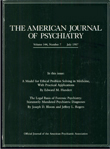Control of Tourette’s Syndrome With Topiramate
To the Editor: Tourette’s syndrome carries the truncated eponym designated after Georges Gilles de la Tourette’s original article was published in 1885 (1). Although numerous therapies have been attempted (2), neuroleptics have been found to be the most effective treatment of Tourette’s syndrome. Seignot’s original success with haloperidol (3) has made Tourette’s syndrome a human assay of dopamine-blocking agents. We report on two patients who met DSM-IV criteria for Tourette’s syndrome who were successfully treated with topiramate while previous medications were tapered and discontinued during the first 2 weeks of treatment.
Ms. A had no family history of Tourette’s syndrome, but she had exhibited facial tics, later accompanied by humming, coprolalia, and palilalia, since age 6. She had tried haloperidol between ages 10 and 19 but developed a stiff tongue and difficulty sleeping. The introduction of risperidone, 1.5 mg/day, had controlled her tics but had caused a weight gain of 37 lb and galactorrhea. Treatment with topiramate, 50–200 mg/day, brought her tics under control within 1 week, but she developed a slight lack of concentration, loss of appetite, and greater thirst. Her weight dropped from 183 to 145 lb in 8 months.
After recovering from pneumonia at age 9, Mr. B had experienced facial tics. The only family history of facial tics was found in his son and maternal uncle. For 15 years he had been treated with clonazepam, 0.5–2.0 mg/day. Risperidone had been prescribed instead, and in 13 months Mr. B had reached his highest weight—228.5 lb. Topiramate was substituted, 200 mg at bedtime, but he felt lethargic. When he took 100 mg at bedtime, his tics were under control, and he experienced few side effects. In a month, Mr. B had a weight loss of 12.5 lb.
Topiramate, a fructopyranose derivative, possesses a structure unlike that of other anticonvulsants. The exact mechanism of action is unknown. It has been shown to potentiate the activity of γ-aminobutyric acid (GABA), an inhibitory neurotransmitter (4), which could control tics. Although Tourette’s syndrome is not a convulsive disorder, other GABA-ergic medications, such as clonazepam, have been effective in controlling tics. Topiramate has advantages over neuroleptic medications in that it carries no risk of tardive dyskinesia. Often, weight loss is highly desired by patients. Topiramate can cause alkaline urine, which may induce kidney stones; acidifying the urine with high doses of ascorbic acid may counteract this risk. A search of scientific literature failed to reveal previous use of topiramate for the treatment of Tourette’s syndrome.
1. Gilles de la Tourette G: Etude sur une affection nerveuse, caractérisée par de l’incoordination motrice, accompagnée d’écholalie et de coprolalie. Arch Neurol (Paris) 1885; 9:19–42, 158–200Google Scholar
2. Abuzzahab FS Sr, Anderson FO: Gilles de la Tourette’s Syndrome. St Paul, Mason Publishing, 1976Google Scholar
3. Seignot JN: Un cas de maladie des tics de Gilles de la Tourette gueri par le R-1625. Ann Med Psychol (Paris) 1961; 119:578–579Medline, Google Scholar
4. Perucca E: A pharmacological and clinical review on topiramate, a new antiepileptic drug. Pharmacol Res 1997; 35:241–256Crossref, Medline, Google Scholar



